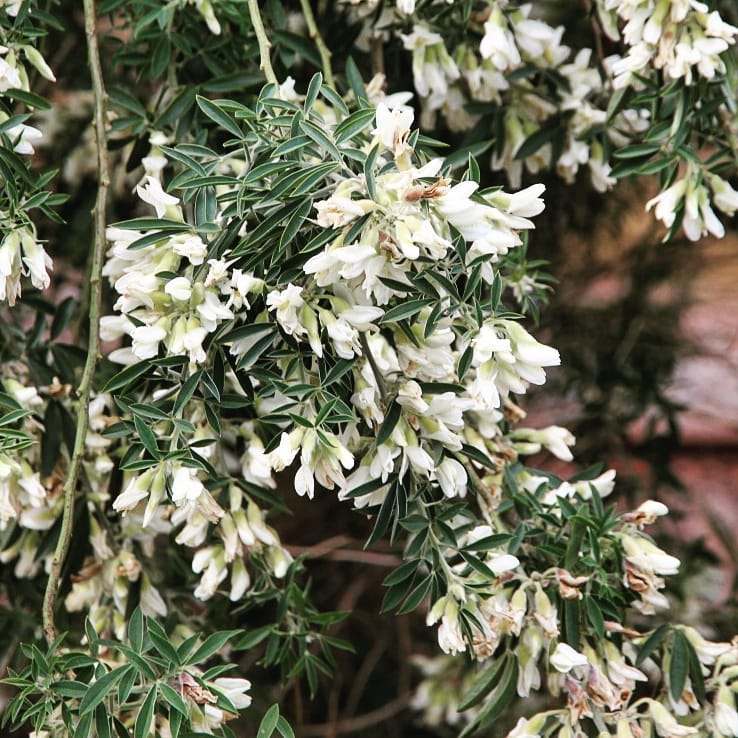
Tagasaste
Chamaecytisus palmensis
Basic Information
🌿 Family: Fabaceae🗺️ Zone: 8-10
Other Names:
- Tree Lucerne
- Cytisus proliferus
🌡️ Ideal Temperature : 60°F (16°C)°F – 77°F (25°C)°F
🔥 Heat Tolerance: Up to 95°F (35°C)°F
❄️ Cold Tolerance: Down to 20°F (-6°C)°F
🌱 Type: Perennial
Layers
- Shrub
- Sub-canopy
Functions
- Nitrogen Fixer
- Animal Fodder
- Erosion Control
- Windbreaker
- Wildlife Attractor
- Pollinator
- Soil Improvement
- Ornamental
Pests
Description
Tagasaste (*Chamaecytisus palmensis*), commonly known as Tree Lucerne, is a fast-growing evergreen shrub or small tree native to the Canary Islands. It typically reaches heights of 3 to 6 meters (10 to 20 feet) and features long, drooping branches with trifoliate, grey-green leaves. The plant produces clusters of small, fragrant, creamy-white pea-like flowers, primarily in spring, though flowering can occur from April to September in some regions. These blooms are followed by narrow seed pods containing hard-coated seeds. Tagasaste is highly valued for its ability to thrive in poor, sandy, well-drained soils and its extensive root system, which can extend down to at least 10 meters, allowing it to access deep soil moisture and nutrients. This deep rooting also contributes to its drought tolerance and effectiveness in soil stabilization.
✂️🫘 **Methods to Propagate:**
Tagasaste is commonly propagated from seeds. Due to the hard seed coat, seeds should be scarified—either by soaking in hot water or mechanically nicking the coat—to enhance germination. Inoculating seeds with appropriate Rhizobium bacteria ensures effective nitrogen fixation. Seeds are typically sown in winter, from May to August, directly into well-drained soil or in nurseries for later transplantation. Spacing recommendations vary; for fodder production, planting in rows with 2 to 3 meters between plants and 8 to 10 meters between rows is common.
🌞💧 **Sun and Water Requirements:**
Tagasaste thrives in full sun and requires well-drained soils to prevent root diseases. It is highly drought-tolerant once established, owing to its deep root system. However, young plants benefit from regular watering until they are well-established. The plant is adapted to a wide range of temperatures but may experience slowed growth during cooler periods and can withstand light frosts, though young leaves may be susceptible to frost damage.
🧑🌾👩🌾 **When to Harvest:**
For fodder purposes, tagasaste can be grazed directly by livestock or cut for cut-and-carry systems. It is advisable to allow the plant to establish for 12 to 18 months before the first harvest. Subsequent harvesting or grazing can occur multiple times per year, depending on growth rates and climatic conditions. Regular pruning or grazing helps maintain the plant in a juvenile, vegetative state, which is optimal for fodder quality and prevents flowering that can reduce palatability.
Purpose
- **Nitrogen Fixer:** Through symbiosis with Rhizobium bacteria, tagasaste enriches soil nitrogen content, benefiting surrounding plants and improving soil fertility.
- **Animal Fodder:** The foliage is highly nutritious, offering crude protein levels between 14% and 30%, making it an excellent year-round feed source for ruminants. Its deep roots access moisture and nutrients beyond the reach of many other forage plants, ensuring green fodder even during dry periods.
- **Erosion Control:** The extensive root system stabilizes soil, making tagasaste effective in preventing erosion on steep slopes and degraded lands.
- **Windbreaker:** When planted in rows, tagasaste serves as a low-level windbreak, protecting other crops or pastures from wind damage.
- **Wildlife Attractor:** The abundant flowers provide nectar and pollen, attracting bees and other pollinators, which supports local biodiversity and can enhance pollination of nearby crops.
- **Soil Improvement:** As a legume, tagasaste contributes to soil organic matter and structure, improving overall soil health and productivity.
- **Ornamental:** Its attractive foliage and profuse flowering make it suitable for ornamental planting in gardens and landscapes.